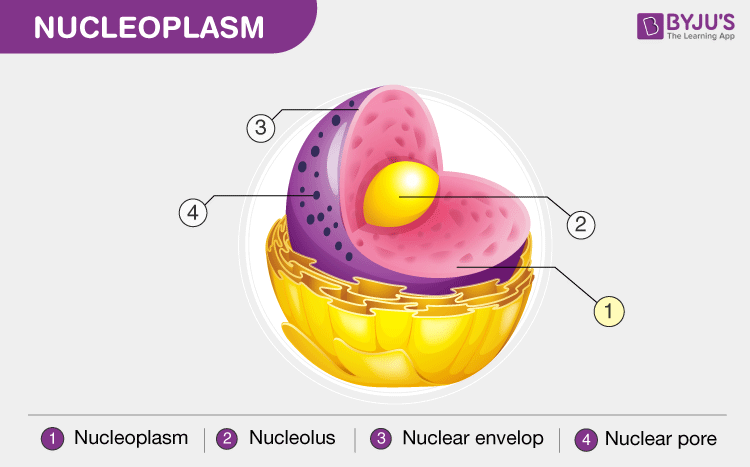Nucleoplasm is a type of protoplasm that is composed of thick fluid and constitutes chromatin fibres made up of DNA and usually found in the nucleus of the eukaryotic cells. This fluid contains primarily water, dissolved ions, and a complex mixture of molecules.
Its primary function is to act as a suspension medium for the organelles of the nucleus.

Nucleoplasm
What is Nucleoplasm?
The nucleoplasm includes the chromosomes and nucleoli. Many substances such as nucleotides and enzymes, which direct activities that take place in the nucleus are dissolved in the nucleoplasm. The soluble, liquid portion of the nucleoplasm is called the nucleosol or nuclear hyaloplasm.
Nucleoplasm also called nuclear sap or karyoplasm. Other functions of nucleoplasm include the maintenance of nuclear shape and structure, and the transportation of ions, molecules, and other substances important to cell metabolism and function.
It is a highly gelatinous, sticky liquid that supports the chromosomes and nucleoli. A soluble, fluid component of the nucleoplasm is called the nuclear hyaloplasm.
Nucleoplasm is found inside the nucleus and resembles cytoplasm is some aspects. It is composed mostly of water, nucleoplasm also has an array of complex components.
However, the difference between cytoplasm and nucleoplasm is that nucleoplasm consists of such materials including nucleotide making them useful in the preparation of RNA and DNA and also the enzymes that influence the building reactions of DNA and RNA.
All these substances and components present inside the cell membrane together are considered as nucleoplasm and hence it comprises of the nucleus, cell fluids, and the organelles.
The principal function of the nucleoplasm is to program as a suspension substance for the organelles inside the nucleus. It also helps to maintain the shape and structure of the nucleus and plays an important role in the transportation of materials that are vital to cell metabolism and function.
Also Read: Nucleolus
Components of Nucleoplasm
The different components of nucleoplasm include:
Nucleolus
It is the major production centre within the nucleus. The ribosomal subunits are produced here and pushed into the rest of the nucleus where they are processed into ribosomes. It is the largest organelle in the nucleus and the organisms will not be able to survive without the nucleolus.
Nucleotides
Nucleotides are also found in the nucleoplasm. They are the building blocks of DNA and RNA. All the nucleotides consist of a base, a phosphate group, and deoxyribose sugar.
Chromatin
It is a complex of DNA, RNA and proteins that helps in the DNA folding. It prevents the entangling of the strings during DNA folding and improves the efficiency of replication. They are also associated with the processes of gene repression, gene expression and transcription.
Nuclear Matrix
It maintains the structure of the nucleus and is found all over the nucleus. It also helps in organizing the genetic material of the cells.
Enzymes
Nucleoplasm comprises of various enzymes that catalyze the reactions occurring in the nucleus. DNA polymerase is the most important enzyme found in the nucleoplasm. Other enzymes present in the nucleoplasm include hexokinase, P-fructokinase, and 6-P-gluconic dehydrogenase.
Also Read: Nucleus
Difference between Cytoplasm and Nucleoplasm
The important difference between cytoplasm and nucleoplasm are as follows:
|
Cytoplasm |
Nucleoplasm |
|
Found inside the cell, outside the nucleus. |
Found inside the nucleus. |
|
Enclosed by the cell membrane. |
Enclosed by the nuclear envelope. |
|
Gelatinous structure. |
Highly gelatinous structure. |
|
Found in all the known cells. |
Found only in eukaryotic cells. |
|
Inclusions and organelles are suspended in the cytoplasm. |
Nucleoplasm is composed of nucleolus and chromatin. |
|
It divides during cytokinesis. |
It is released during nuclear division and is refilled after the nuclear envelope forms. |
The processes that occur in the nucleoplasm include transcription, replication, necessary for the survival of a eukaryote.
To know more about nucleoplasm, its components, and the difference between cytoplasm and nucleoplasm, keep visiting BYJU’S website or download BYJU’S app for further reference.
Frequently Asked Questions
What is nucleoplasm?
It is a protoplasm type substance that is present throughout the cell body outside the nucleus. It is composed of a thick fluid and chromatin fibres.
What is the main function of nucleoplasm?
It supports the chromosomes and the nucleoli. It serves as the suspension substance for the organelles inside the nucleus.
Do animals cells have nucleoplasm?
Yes, the animal cells contain a nucleoplasm. It functions as the cytoplasm of the cell.
What is the function of chromatin?
The chromatin packages the DNA into a small unit such that it fits into the nucleus. It also protects the DNA structure and sequence. It controls gene expression and replication and prevents chromosome breakage.
What is the difference between cytoplasm and nucleoplasm?
The cytoplasm is found in all the cells while nucleoplasm is found only in eukaryotic cells. The cytoplasm is the fluid mass of the cell consisting of organelles whereas nucleoplasm is the sap of the nucleus that contains nucleoplasm.

Comments